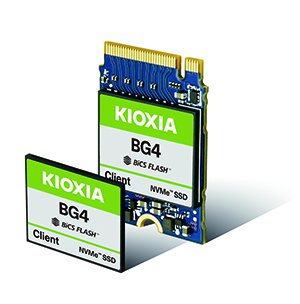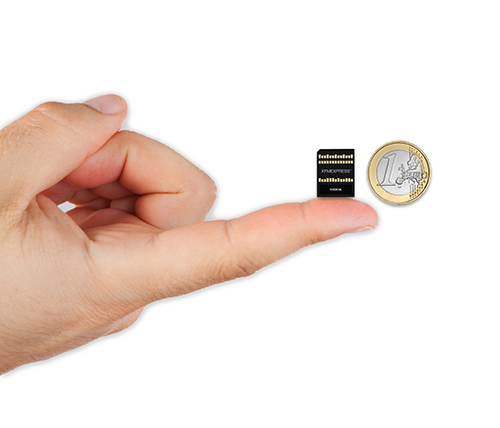Memory storage: compact and serviceable
When it comes to selecting memory storage for new applications, design engineers and product developers seemingly have a wealth of storage choices at their fingertips. Bruno Trematore, Chief Engineer, Kioxia explains more.
Compact form-factors, such as the M.2 SSDs, offer terabytes of capacity and commonly find a home on the motherboards of servers, PCs, and laptops. However, when ultimate compactness is the goal for wearables, IoT devices, and home entertainment systems, ball-grid array (BGA) memories that solder directly to the circuit board (PCB) are space-saving and reliable (Figure 1).
However, there is a growing focus on the lifespan of the consumer products being brought to market. Anyone with a smartphone knows how, over time, with app updates and operating system upgrades, the memory capacity seems to rapidly dwindle. Many home appliances, such as smart speakers, replace the simple audio devices of yesteryear. But, as security patches are issued to respond to the latest attack methods, and features and services are extended, such devices can suddenly become obsolete as firmware images grow larger than the available storage capacity.
The burgeoning challenge of the resultant e-waste has been highlighted by the World Health Organization (WHO), especially the impact on children in areas where poor recycling methods are employed. The German Federal Environment Agency (Umweltbundesamtes - UBA) has also highlighted the shortening usage span of electrical goods. Their study noted that appliances are increasingly being replaced ‘although they still work well’.
Balancing price point against serviceability
The challenge here is that to attain a price point acceptable to the market, the memory of such products are aligned with the functionality requirements at the time of development. For sure, some headroom is also factored in. However, it is difficult to champion the use of a 512GB memory that may be required a decade from now when 256GB provides enough room for foreseeable upgrades and software patches today.

Above: Figure 1. Today’s storage technology form factors offer a choice between compact design or being serviceable, both not both
With demand for slim, compact, and lightweight electronics seeming to have no end in sight, this leaves development teams with a tricky choice: do they tend towards a bulkier solution offering upgradeable, replaceable storage, such as an M.2 SSD? Or do they remain compact with soldered down storage, such as a Universal Flash Storage (UFS) BGA, and leave no upgrade path?
Time for innovation in memory packaging
While M.2 SSDs are well-established amongst system builders, the general consumer is less acquainted with this form factor, nor the connector system it employs. Such storage technology should also be handled while wearing and using appropriate ESD (electrostatic discharge) equipment. Furthermore, replacement requires an appropriate screwdriver, adding more risk of damage when undertaken by a layperson.
To fill this choice-gap between serviceability and compactness, KIOXIA has developed a new packaging approach coupled with an innovative connector solution. Named XFMEXPRESS, this compact and thin form factor memory technology offers support for both PCI Express (PCIe) and NVM Express (Figure 2). Supporting both base 1-lane and 2-lane PCIe.
With a thought to the needs of the consumer, perhaps the cleverest aspect of this concept is the packaging and connector design. Its similarity with SD cards, with gold-plated contacts embedded into a package featuring a corner notch, provides them with confidence through familiarity. The connector, too, is reminiscent of some SIM card holders, featuring a fold-down door that latches confidently in place.
The XFMEXPRESS card dimensions of 18x14mm (252mm²) are so compact that it can just be covered by a €1.00 coin. And, compared to a M.2 2230 module form factor, XFMEXPRESS requires 62% less area to accommodate it. Its 1.4mm thickness is another area of advantage. M.2 modules can be slim, but even single-sided modules struggle to get below a thickness of 2mm. On top of this the connector also needs to be factored in too. State-of-the-art connectors have a thickness of more than 2.2mm themselves and, once the M.2 module has been inserted, it will protrude at least 0.6mm plus its own thickness above the surface of the main PCB.

Above: Figure 2. XFMEXPRESS provides the compactness of BGA SSDs coupled with the serviceability of M.2 SSDs
By comparison, the XFMEXPRESS connector is exceptionally compact. Once securely closed with the selected memory card it is only 2.2mm thick. It is also very low in weight, adding just 0.8g to the XFMEXPRESS card’s weight. Unlike SD cards, this approach allows watertight designs to be implemented, rather than requiring a slot to be included that allows the ingress of water and dust.
Integration into existing and future applications is simplified thanks to the compatibility with PCIe and NVMe. This interface and protocol are commonly available in the system-on-chip (SoC) processors being used in today’s advanced wearable products and IoT solutions. The current theoretical bandwidth lies at up to 2GB/s, ensuring the applications remain responsive, and graphical user interfaces provide a fluid experience. Battery life is another key metric, and the specification ensures that the common power states (PS0 through PS4) and APST (Automatic Power State Transition) are all available. Power supply requirements are also simple with support for common voltage rails of 2.5V, 1.8V and 1.2V.
Furthermore, the card design has been developed with today’s 3D flash memory technology in mind, along with the die-stacking techniques required to attain the capacities needed by developers. As a result, capacities of up to 1,024GB using KIOXIA’s 3D BiCS FLASH are currently possible with existing memory die.

Above: Figure 3: At just 18x14mm, the XFMEXPRESS card form factor can just be hidden behind a €1 coin
Summary
The introduction of XFMEXPRESS opens more flexibility to application designers, providing the ability to select storage needs that meet today’s price points while affording an upgrade path for the future. This allows electronics brands to improve their credentials in the space of appliance obsolescence, making their connected ecosystems more attractive to consumers, but without having to compromise on the miniaturisation goals.
Design teams benefit from a standard that builds upon existing interfacing standards that are already supported by the wide range of SoC technology upon which they commonly develop. Designed with the demands of 3D flash technology in mind, such as 3D BiCS FLASH, and with future support new PCIe generations, this convenient card format has everything needed for a reliable, capable storage technology that will be trusted for years to come.


